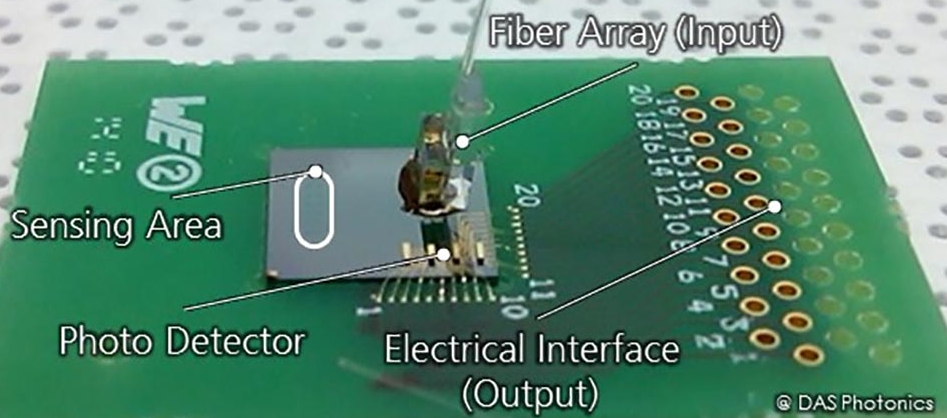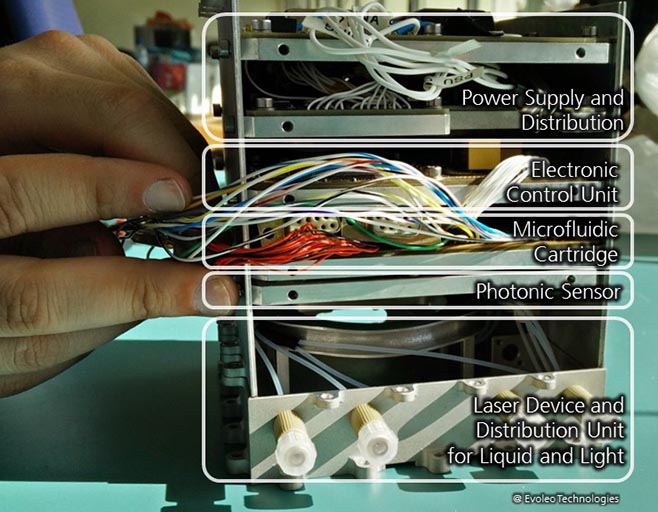Development of a mobile diagnostic platform for the use on self-contained, exploration rovers within harsh environments



Missions within terrestrial or space environments delivering risks to human encounter need to be analyzed by self-contained, exploration rovers. Beside imaging tasks, biochemical analyses are one major goal. Where the retrieval of the robot is not possible or desirable, the analyses have to be done on the spot. This leads to the demand of automation of biochemical analyses within a smart, mobile system which is capable of driving the analysis process and analyzing the recorded data.
Sensitivity through photonic sensing
The system is built around a photonic-based biosensor with an array of sensing elements for the detection of multiple analytes (DAS Photonics SL, Spain). The photonic biosensor uses a laser source which couples light into the chip through an optical fiber. The light is transmitted through the chip and split up onto a number of sensing elements. Due to biochemical coupling processes the photonic signal changes. The integrated photo detector array transfers the optical signal to an electrical signal which can easily be amplified and evaluated.
The characteristics of the photonic sensor were enabled by the functionalization of the sensing elements (INTA, Spain). This allows for example the selective and highly sensitive detection of a set of target analytes for life detection tasks on extraterrestrial exploration missions (Fig. 1).
Mobility through microfluidic integration
Since biosensors can be highly miniaturized and necessary reagent volumes are within the microliter range, tubes, valves, and actuators are in the focus of miniaturization. The integrable electrolysis actuation method developed by Fraunhofer allows the desired integrated, automated assay processing (Fig. 2). Within the project a new cartridge was developed which is specialized to the needs of the assay (number and volume of reagents), remote sample filling, photonic sensor mounting, and automated assay processing.
Independency through system-level integration
Both subsystems, the biosensor and the microfluidic one, need an electronic infrastructure to perform. In cooperation with Evoleo Technologies Lda (Portugal) power supplies, photonic and microfluidic driving electronics and signal amplification were miniaturized. The hardware can be remotely controlled through an on-board operating system (Fig. 3).
Results
The newly developed subsystems were technologically evaluated in combination and separately. Even radiation tests with gamma and proton exposure were done to prove the capability to last under harsh environmental conditions. Eventually, the system was successfully applied to a biochemical assay under the use of different target analytes with no human interaction needed at all.
Conclusion
A multidisciplinary approach was shown, where highly integrated microfluidics were combined with a sophisticated photonic sensor suitable to allow protein measurements with an one-step analytic device. The project miniaturized the necessary electronic equipment (like laser systems and power distribution units) and combined it with a microfluidic cartridge and a biosensor into a small package.
Acknowledgement
The authors would like to thank the European Union for their funding of the project PBSA “Photonic Biosensor for Space Application” within the FP7-program (FP7 program Grant Agreement No. 312942-PBSA; http://www.pbsa-fp7.eu/).
 Fraunhofer Institute for Electronic Nano Systems
Fraunhofer Institute for Electronic Nano Systems